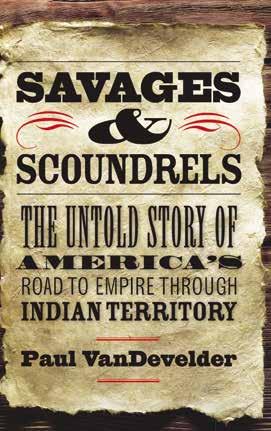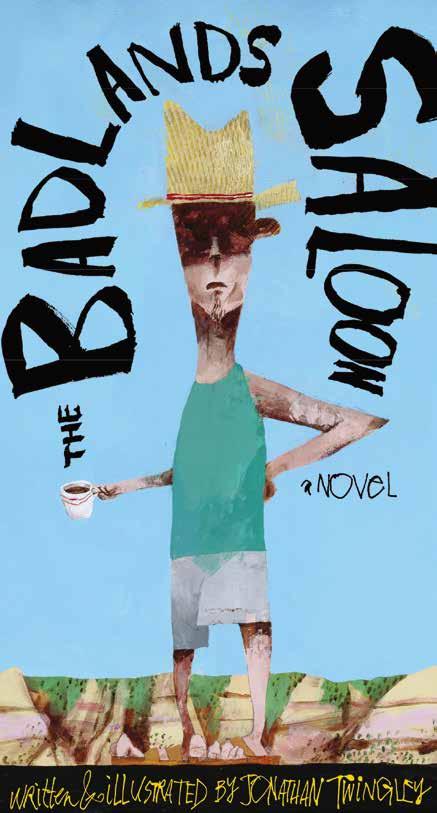
14 minute read
The On-Again, Off-Again Mexican Border
By Jim Norris
Borders, border security, fences, electronic surveillance measures, immigrants, and undocumented immigrants are words often in the news these days. Our concern about these matters in the United States is a reflection of fears engendered partly by 9/11, partly by our current economic woes, partly by the recent election-year politics, and partly by the media’s need to have something to talk and write about. Our nation has gone through this cycle of “alien” anxiety numerous times before with immigrants from various parts of the globe. We worried about the papist Irish before the Civil War, we excluded Chinese and Japanese in the late-1800s, and we sought to secure our nation from eastern European “anarchists” prior to World War I. So, too, has concern about Mexican immigrants and the security of the border with Mexico gone through various cycles of interest, which is why I refer to it as the “on-again, off-again” border.
Advertisement
Before launching into a narrative on the Mexican-U.S. border, it will be helpful to think about what a border represents and why people cross them. A border, or a nation’s boundary, delineates the territory claimed by that nation. Since that part of our planet is owned by the nation, we infer that the nation’s government should guard and protect that land mass. Moreover, we usually accept that a country strives to preserve its holdings most often from people not originally from the nation; we control our borders to keep others from gaining control over us and our resources. People cross borders, going from one nation to another, usually because they are compelled to do so or they are invited. Historians of immigration usually cast this as “push-pull” factors. What pushes people from their native land, and what pulls them toward another? War, famine, disease, and financial woes most often force people to migrate. The place they opt to go is most often based on economic opportunity and/or escape from fear.
We established the border with Mexico as a result of war: the Mexican-American War or, as it is called in Mexico, the War of the North American Invasion. The Treaty of Guadalupe Hidalgo, that concluded the conflict, stipulated that the boundary would be from the Rio Grande to within a few miles north of El Paso, Texas. However, the United States decided it wanted more Mexican territory because engineers believed the easiest site to build a transcontinental railroad through the Rocky Mountain chain was a place called the Mesilla Valley, in Mexico. Fearful of another war with the United States, Mexico this time decided to sell to the U.S. the Mesilla Valley. Thus, the Mexican-U.S. border received its final shape (save for some inconvenient shifts in the Rio Grande’s flow).
Not that the Mexican border was an important entity in the lives of United States’ citizens, however. Over the next sixty years, there was not really any need to care about the boundary because not many people lived nearby, and push-pull factors, by and large, were not present. For the Mexicans and Americans that did live nearby, border crossings were unimpeded, unless one happened to be an Apache being pursued by either the Mexican or American army, or one was engaged in criminal acts, such as cattle rustling. Otherwise, one crossed the border whenever so inclined without any formalities.
The first push-pull situation along the border emerged just before World War I. Railroads began to bring more Americans into border regions at the turn of the century, especially in Texas. As U.S. citizens settled in greater numbers along the Rio Grande, many of the newcomers began to develop large-scale agricultural operations. This required, of course, greater numbers of workers to maintain the railway system, clear the land of brush, erect irrigation systems, and cultivate and harvest crops. This “pull” factor coincided with the outbreak of the Mexican Revolution in 1910. The decade long conflict ravaged Mexico, resulting in the loss of millions of lives and devastating the Mexican economy. Perhaps as many as 250,000 Mexicans were “pushed” across the Rio Grande looking for jobs and safe havens. Moreover, during World War I, U.S. railroad companies and agribusinesses, fearing labor shortages, pressured the federal government to encourage Mexican workers to enter the country. Thus, the first bracero program occurred, which enticed another 80,000 Mexicans to enter the United States in 1917-18.
Prior to World War I, the United States had really never done much to keep people out of the country. While hostile attitudes toward certain immigrants emerged during the 1800s, most notably regarding the Irish, not much was done to retard their entry. It was not until 1875, that the federal government enacted legislation against potential immigrants when Congress created a category of “undesirables,” which included criminals and prostitutes. In 1882, the Chinese were barred from entering the United States. In the first decade of the twentieth century, the government added political anarchists and “the feebleminded” to this list of undesirables and established a four dollar head tax on each immigrant.

Jim Norris's latest book, North for the Harvest: Mexican Workers, Growers, and the Sugar Beet Industry, examines the complex and often surprising relationships among the participants in the sugar beet industry.
However, the Bolshevik revolution in Russia, and communist uprisings in several European countries immediately after the war helped spawn a fear of immigrants in this country. In response, the federal government established quotas on immigrants based on nationalities. In 1924, Congress enacted a landmark measure regarding immigration. Referred to as the Immigration Act of 1924, or the ReedJohnson Act, Congress decreed very low yearly quotas on the number of immigrants who could enter the country, required a passport or visa for entrance, raised the head tax to five dollars, and expanded the list of undesirables (most notably adding alcoholics and people suffering from epilepsy). Even more importantly, Congress, for the first time, appropriated money for the creation of a border security force (Border Patrol). With minor adjustments, the Immigration Act of 1924 governed immigration into the U.S. for the next four decades.
Interestingly, the Immigration Act of 1924 omitted a nationality from the restrictive quotas: Mexicans. Railroad companies and agricultural interests, fearing the new immigration policy would restrict the labor pool and drive up wages, lobbied Congress to exempt Mexican immigrants. Indeed, with the expanding railroad networks and agricultural operations west of the Mississippi, such as sugar beets in the Red River Valley, the “pull” factor for Mexicans increased even more during the 1920s. Coupled with the fact that Mexico’s economy was slow to recover during the 1920s, creating strong “push” conditions, about 250,000 additional Mexicans crossed the border with little scrutiny during the decade after World War I.
The Great Depression, starting in 1929, changed the “pull” conditions for Mexicans. Indeed, the United States government quickly moved to discourage Mexicans from entering the country. In 1930, the newly deployed Border Patrol received instructions to start rigorously enforcing immigration regulations along the U.S.-Mexican border. While no quotas existed for Mexicans, they still had to conform to various other requirements, i.e., literacy tests, paying the five-dollar head tax, and undergoing a medical examination. In this manner, legal immigration of Mexicans into the U.S. dropped sharply from 60,000 in 1929, to only 11,000 in 1930.
More harshly, however, was the repatriation campaign against Mexican residents that occurred between 1932 and 1935. During those years, the federal government encouraged state and local government entities to pressure Mexicans to leave the U.S. The most common tool in this drive became New Deal relief measures; state, county, and city boards that managed New Deal programs simply refused to provide assistance to Mexican people. On the other hand, if Mexicans were willing to leave the country, their transportation was paid to the border. Through this measure and others—sometimes more threatening—perhaps as many as 500,000 Mexicans were forced out of the country, many of whom were citizens of the United States.
The “on again” border did not last long. By the end of the 1930s, New Deal programs had created enough jobs that Anglos, who perhaps had been reduced to working in agriculture, could once again shun stooped labor, such as sugar beet cultivation. Border Patrol agents also reduced their strict scrutiny of Mexicans entering the country. When the United States was attacked at Pearl Harbor and millions of Americans rushed to join the armed forces, fears of labor shortages induced the United States government to negotiate with Mexico for agricultural workers. The “pull” for Mexican workers again intensified. Within six months of the U.S. entry into World War II, the so-called Bracero Agreement with Mexico was signed.
In fact, this bracero arrangement also set the stage for a long running, massive violation of the U.S.-Mexican border. A stipulation that Mexico insisted upon in the agreement stated that Mexico could forbid braceros to be utilized in any American states that practiced widespread discrimination against Mexican people. Texas had numerous segregation laws in place against both African Americans and Mexicans. When the state refused to remove these segregationist measures, the Mexican government barred braceros from working in Texas. Texas farmers, fearing labor shortages, were outraged and called on their political leaders to do something. Unable to change the terms of the bracero agreement, Texas politicians did put significant pressure on federal border agents and state law enforcement to ignore immigration regulations along the Rio Grande. Hence, during the war, about 250,000 braceros entered the U.S. legally, while thousands of Mexicans entered Texas illegally to work.
This situation, braceros and illegal Mexican workers in the U.S., continued for the next two decades. For one thing, the “pull” factor remained strong. With so many Americans leaving rural areas for the city, the farm labor pool would have shrunk, driving wages higher. To counter that, farmers and agribusinesses lobbied for an extension of the bracero agreement with Mexico, which the federal government did renew each year until 1964. Mexico continued to restrict braceros from Texas, however, the lax border enforcement along the Rio Grande prevailed. In 1950, a Border Patrol official estimated in his district alone 100,000 illegal Mexican workers resided.
In addition, the “push” factor remained high during this era. Mexico’s economy did grow remarkably during World War II and the 1950s, but it could not keep up with Mexico’s massive population growth. Thus, by 1959, the less than diligent Border Patrol agents still apprehended 1.3 million Mexicans entering the U.S. They estimated that this number represented one-fourth of the total that crossed the border illegally that year.
Only briefly, during these two decades, did the United States government attempt to stem this flow of humanity over the border with Mexico. In response to labor union pressures on the federal government that the flow of Mexicans into the country undermined wages and an economic recession brought on by the end of the Korean War, the U.S. launched “Operation Wetback” in 1954. Over the next eighteen months the Immigration and Naturalization Service (INS) with its Border Patrol agents significantly strengthened border security and sought to catch those Mexicans in the United States without documentation. Reminiscent of the repatriation campaign of the early 1930s, Operation Wetback resulted in the arrest and deportation of 1.3 million Mexicans. Again, many of these were citizens of the United States. By 1955, however, the campaign ended and the maintenance of the Mexican border reverted to “off again” status.
While the American economy remained robust in its demand for cheap agricultural labor during the 1960s, a weaker economy during the 1970s into the early 1980s led to public concerns about immigrant labor in the U.S. Furthermore, the United States was accepting large numbers of Cubans annually into the country, and the loss of the conflict in Vietnam led the U.S. to allow over one million refugees from Southeast Asia to enter the country. At a time when Mexico’s “push” factor was growing, the United States could not offer such an abundant “pull” as before. Therefore, the American public expressed more and more concern about undocumented Mexican immigrants with the INS apprehending more than one million each year. Under this public pressure, Congress enacted in 1986 the Immigration Reform and Control Act, which provided amnesty for 2.7 million undocumented immigrants in the United States, the vast majority of whom were Mexicans, and provided legal sanctions against employers who knowingly hired undocumented immigrants. While hailed as a milestone solution to unlawful immigration, when enacted the measure had little effect on securing the U.S.-Mexican border.
Several factors continued to build pressure on the boundary. First, more Mexicans were migrating northward to border towns. Mexico had initiated the Border Industrialization Project (popularly known as the maquiladores) during the 1960s. The maquilodores were factories owned by foreign companies (mostly U.S.) that were exempt from Mexican tariffs. In essence, foreign corporations could ship materials to Mexico to be assembled and then bring the finished products back into the United States without paying any duties. The project stipulated that the assembly plants had to be located within ten miles of the border with the U.S. The number of maquiladores there exploded in the 1980s because American companies could pay Mexican workers less wages than their American counterparts (and also evade U.S. environmental laws). By the mid-1980s, over 500,000 Mexicans worked in the maquiladores. Unfortunately, Mexico’s population boom still vastly exceeded what these factories could employ. Thousands of Mexicans journeyed each year to border towns. Some found employment, but most did not. Making the problem more acute was that Mexico’s economy virtually collapsed in the late 1980s leading to the most severe “push” condition since the Mexican Revolution.
The American “pull” factor increased at this time, too. The U.S. economy boomed during much of the 1990s, and employers in many cases viewed Mexican workers as an attractive human resource. Mexican workers, whether legally in the country or undocumented, often were paid less in wages and benefits than American workers would accept. Agribusinesses especially were drawn to those in the country illegally; fifty percent of all farm laborers were undocumented during the mid-1990s.
Many Americans were alarmed about the large numbers (estimates ran as high as three million per year) of undocumented Mexicans crossing the border. In California, voters passed Proposition 187 in 1994, which was to deny health, education, and other social services to undocumented immigrants. That same year, the so-called Arizona Militia formed, a group dedicated to “defending” the U.S. border with Mexico from the “hordes” crossing illegally into Arizona. This anger against undocumented immigrants helped fuel the 1994 Republican “revolution.” Part of the “Contract with America” stipulated that immigrants in the U.S. illegally should be denied welfare and other benefits. The Republican controlled Congress then passed numerous immigration laws in 1996 that restricted public benefits for all immigrants during their first five years in the country; provided stronger criminal penalties against those entering the country illegally, smuggling immigrants, or hiring undocumented immigrants; and provided money for more border patrol agents and equipment. The U.S.-Mexican border clearly became more militarized beginning in 1996, a development enhanced by worries regarding drug smuggling into the United States.
Of course, the terrorist attacks of 9/11 have led to further concerns regarding the security of American borders, especially with Mexico. More and more Border Patrol personnel have been added to police the boundary, contractors have begun a fence to be erected along the entire border, and within the past few years National Guard units have been assigned to the region. There are those who believe that the U.S. military should be included in securing the boundary, often described as a sieve, by which undocumented immigrants, drugs, and potential terrorists pour through. Vigilante groups, such as the aforementioned Arizona Militia, also patrol the border. It seems all of this is having perhaps some effect; recent news reports in Mexico indicate a significant drop in Mexicans leaving for the United States. Certainly with the severe recession currently plaguing the United States, the “pull” factor is significantly reduced.
Will this intense border security and Mexican immigration concern continue? Will the border stay “on?” Certainly as long as the U.S. is threatened by terrorism, strict maintenance of the border will continue. The only comparable historical event was the militarization of the border after Pancho Villa’s raid on Columbus, New Mexico in 1917. That only lasted briefly, however, because Villa’s capacity to threaten the U.S. border was limited and lasted only a short time. In less than three years, Villa retired to his hacienda. Moreover, the army’s buildup on the border was never concerned with Mexican immigrants. The current effort to slow Mexican immigration, whether lawful entrance or not, will likely depend on the state of the U.S. economy. As long as American unemployment is high, the U.S. will continue the effort to restrict Mexicans from entering the country. If the economy begins to grow rapidly again, the desire to keep wages and prices low (especially on food) will likely recreate “pull” conditions and the U.S.Mexican border, at least in regard to people willing to work, will be “off.”
-- Jim Norris is an associate professor of history at North Dakota State University. He is the author of After the Year Eighty: The Demise of Franciscan Power in Spanish New Mexico.









